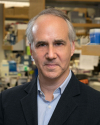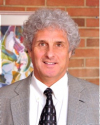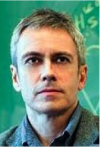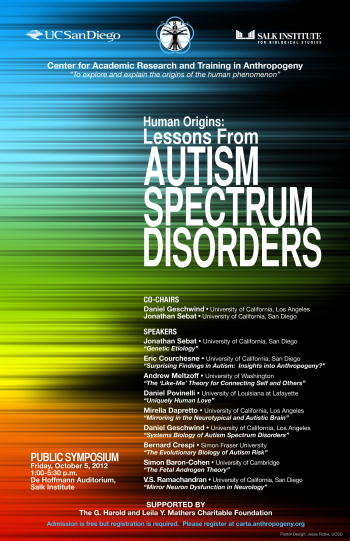Human Origins: Lessons from Autism Spectrum Disorders
Daniel Geschwind, University of California, Los Angeles
Jonathan Sebat, University of California, San Diego
Autism spectrum disorder (ASD) is very commonly diagnosed these days, possibly due to increased awareness. Or are these signs that the human brain is developing in new and different ways that have yet to be understood? What have advances in our understanding of the etiologies of ASD taught us about its mechanisms, and can they shed light on the evolution of the human brain? The CARTA public symposium on “Human Origins: Lessons from Autism Spectrum Disorders” featured scientists from many diverse fields, including genetics, neuroscience, psychiatry, cognitive science, psychology, and evolutionary biology, who shared their insights into ASD--providing a multi-disciplinary perspective on this multi-faceted spectrum of disorders, and its implications for understanding human origins and the evolution of the human mind.
Media for each talk can be played by clicking on icons in the table below, or by clicking on the individual talk titles below and then the attachment file at the bottom of the page.
| Speakers | Media | Session |
|---|---|---|
 Pascal Gagneux |
|
Welcome |
 Daniel Geschwind |
|
Opening Remarks |
 Jonathan Sebat |
|
Genetic Etiology The Autism Spectrum is a diverse group of neurodevelopmental disorders that share a common set of characteristics, which includes restricted interests, repetitive behaviors and difficulties with social interaction and communication. The biggest known risk factors for autism are genes. However, the mutations that have been firmly implicated in autism are unlike the genetic variants that explain common late-onset diseases such as heart disease and diabetes. Most of the genes or genomic regions... read more |
 Eric Courchesne |
|
Surprising Findings in Autism: Insights into Anthropogeny? Although the neurobiology of autism has been studied for more than two decades, the majority of studies have examined brain anatomy 10 or more years after the onset of clinical symptoms. The early neural defects that cause autism remain unknown, but their signature is likely to most evident during the first years of life when clinical symptoms are emerging. This lecture highlights several new findings about the neural and genomic abnormalities in autism at young ages. It contrasts brain... read more |
 Andrew Meltzoff |
|
The "Like-Me" Theory for Connecting Self and Others This talk describes new research on the origins of ‘social cognition’—the mechanisms by which infants come to understand other people and interpret their actions and intentions before language. Typically developing children learn quickly and easily from observing the actions performed by others. This is supported by two key building blocks—imitation and gaze following—that are operative in early infancy, rare in the animal kingdom, and impaired in children with autism spectrum disorders. I... read more |
 Karen Pierce |
|
The Early Identification of Autism: Examinations of Brain and Behavior Autism is a developmental disorder impacting one out of every 100 children born today. It is a disorder that affects how the brain grows and works, yet the functional brain characteristics of autism during the time when symptoms first appear, namely 12-36 months, is almost completely unknown. This is because autism remains behaviorally defined and diagnosed, thus limiting the ages that it can be studied. New early identification approaches, however, such as the 1-Year Well-Baby Check-Up... read more |
 Mirella Dapretto |
|
Mirroring in the Neurotypical and Autistic Brain First discovered in the macaque, mirror neurons – neurons that fire when executing a goal-directed action as well as when observing the same action being performed by others – are thought to provide a neural mechanism whereby others’ actions and intentions can be readily understood. More recent findings, including single cell recordings in humans, suggest that mirroring is not a peculiar property of the motor system but a more common phenomenon whereby vicarious neural activity may also be used... read more |
 Daniel Geschwind |
|
Systems Biology of Autism Spectrum Disorders Our laboratory has been working to identify autism risk genes and understand how these might lead to autism spectrum disorders (ASD). Many genes with distinct functions have been identified as ASD susceptibility genes. Our efforts using systems biology approaches demonstrate that pathways necessary for normal brain development and function are altered in ASD. Identification of these pathways has allowed us to begin to understand what these tell us about autisms etiology and aid in the... read more |
 Bernard Crespi |
|
The Evolutionary Biology of Autism Risk I describe a simple model, based in evolutionary biology, neurodevelopment, and genetics, for understanding how the primary features of autism are related to the major neuroanatomical and cognitive traits that are highly-developed or unique to the human lineage. By this model, human-specific adaptations, especially brain size and brain structures that subserve social interactions, are explicitly connected with their alterations in autism spectrum conditions. This evolutionary-medical... read more |
 Simon Baron-Cohen |
|
The Fetal Androgen Theory Autism affects males much more often than females. The explanation for this must either lie in diagnostic practice (e.g., there may be under-diagnosis of females due to their better surface social skills), hormones (e.g., the sex steroid hormones such as testosterone, which is converted into estradiol/estrogen, both of which affect brain function and brain development), genetics (e.g., X-linked genes, or genes regulating sex steroid hormones) or (most likely) a mix of all three factors. In this... read more |
 V.S. Ramachandran |
|
Mirror Neuron Dysfunction in Neurology My interest in Autism Spectrum Disorders (ASD) stems from an earlier, and broader, interest in mirror neurons and their dysfunction (and restitution of function) in neurology. We begin with a brief survey of the mirror neuron system (MNS) seen from an evolutionary perspective and deal with some criticisms (mainly by psychologists and philosophers). We then make specific predictions of what to expect from their dysfunction in neurological populations with stroke or phantom limbs (and current... read more |
 Daniel Geschwind  Jonathan Sebat |
|
Wrap-Up and Question and Answer Session |
 Margaret Schoeninger |
|
Closing Remarks |
| Attachment | Size |
|---|---|
| 973.66 KB |
If you enjoy this event, please consider supporting CARTA's quest to explore and explain the human phenomenon.


